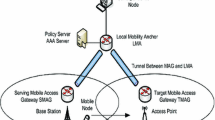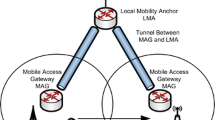Abstract
The exponential growth of the number of multihomed mobile devices is changing the way how we can connect to the Internet. Our mobile devices are demanding for more network resources, in terms of traffic volume and QoS requirements. Unfortunately, it is very hard for a multihomed device to be simultaneously connected to the network through multiple links. The current work enhances the network access of multihomed devices, agnostically to the deployed access technologies. This enhancement is achieved by using simultaneously all of the mobile devices interfaces, and by routing each individual data flow through the most convenient access technology. The proposed solution is only deployed at the network side and it extends Proxy Mobile IPv6 with flow mobility in a completely transparent way to mobile nodes. In fact, it gives particular attention to the handover mechanisms, by improving the detection and attachment of nodes in the network, with the inclusion of the IEEE 802.21 standard in the solution. This provides the necessary implementation and integration details to extend a network topology with femtocell devices. Each femtocell is equipped with various network interfaces, supporting a diverse set of access technologies. There is also a decision entity that individually manages each data flow according to its QoS requisites. The proposed solution has been developed and extensively tested with a real prototype. Evaluation results evidence that the overhead for using the solution is negligible as compared to the offered advantages such as: the support of flow mobility, the fulfil of VoIP functional requisites, the session continuity in spite of flows mobility, its low overhead, its high scalability, and the complete transparency of the proposed solution to user terminals.













Similar content being viewed by others
References
Cisco. (2015). Cisco visual networking index: Global mobile data traffic forecast update, 2014–2019. USA.
ITU. ICT facts & figures. Geneva, Switzerland, May 2015.
Alcatel-Lucent. (2012). Turning Wi-Fi hotspots into a hot business opportunity for wireless service providers.
Oliva, A., Bernardos, C., Calderon, M., Melia, T., & Zuniga, J. C. (2011). IP flow mobility: Smart traffic offload for future wireless networks. IEEE Communications Magazine, 49(10), 124–132.
Moura, J., & Edwards, C. (2016). Future trends and challenges for mobile and convergent networks. In book 4G & beyond: The convergence of networks, devices and services. Nova Science Publishers, 2015.
Ashraf, K., Amarsinh, V., & Satish, D. (2013). Survey and analysis of mobility management protocols for handover in wireless network. In IEEE 3rd international advanced computing conference (IACC) (pp. 413–420).
Al-Surmi, I., Othman, M., & Ali, B. M. (2012). Mobility management for IP-based next generation mobile networks: Review, challenge and perspective. Journal of Network and Computer Applications, 35(1), 295–315.
Yap, K.-K. (2013). Using all networks around us. Ph.D. Dissertation, Stanford University.
Yap, K.-K., Huang, T.-Y., Kobayashi, M., Yiakoumis, Y., McKeown, N., Katti, S., et al. (2012). Making use of all the networks around us. ACM SIGCOMM Computer Communication Review, 42(4), 455.
Gundavelli, S., Leung, K., Devarapalli, V., Chowdhury, K., & Patil, B. (2008). Proxy mobile IPv6. RFC 5213 (Standard).
Melia, T., Bernardos, C. J., de la Oliva, A., Giust, F., & Calderon, M. (2011). IP flow mobility in PMIPv6 based networks: Solution design and experimental evaluation. Wireless Personal Communications, 61(4), 603–627.
Giust, F. (2011). IP flow mobility support for proxy mobile IPv6 based networks. M.S. Thesis, Università degli Studi di Padova.
Corujo, D., Guimaraes, C., Santos, B., & Aguiar, R. (2011). Using an open-source IEEE 802.21 implementation for network-based localized mobility management. IEEE Communications Magazine, 49(9), 114–123.
Capela, N., & Sargento, S. (2014). Multihoming and network coding: A new approach to optimize the network performance. Computer Networks, 75, 18–36.
Capela, N., & Sargento, S. (2015). An intelligent and optimized multihoming approach in real and heterogeneous environments. Wireless Networks, 21(6), 1935–1955.
Müller, Andreas, Klenk, Andreas, & Carle, Georg. (2008). Behavior and classification of NAT devices and implications for NAT traversal. IEEE Network Magazine, 22(5), 14–19.
Silva Santos, B. F. (2011). Implementação de Gestão de Mobilidade Localizada usando PMIPv6. M.S. Thesis, Universidade de Aveiro.
Iapichino, G., & Bonnet, C. (2010). Experimental evaluation of proxy mobile IPv6: An implementation perspective. In 2010 IEEE wireless communication and networking conference (pp. 1–5).
Perkins, C., Johnson, D., & Arkko, J. (2011). Mobility support in IPv6. RFC 6275 (Standard).
Chowdhury, K., Devarapalli, V., Gundavelli, S., & Han, Y.-H. (2013). draft-ietf-netext-pmipv6-flowmob-08.
Murtadha, M. K., Noordin, N. K., & Ali, B. M. (2015). Survey and analysis of integrating PMIPv6 and MIH mobility management approaches for heterogeneous wireless networks. Wireless Personal Communications, 82(3), 1351–1376.
Magalhães Guimarães, C. E. (2011). Discovery of media independent services for heterogeneous networks. M.S. thesis, Universidade de Aveiro.
IEEE. (2009). IEEE standard for local and metropolitan area networks: Media independent handover services—Part 21: Media Independent Handover Services, IEEE Std 802.21.
Piri, E., & Pentikousis, K. (2009). IEEE 802.21: Media independent handover services. The Internet Protocol Journal, 12, 7–27.
Barden, R. (1989). Requirements for InterNet hosts-application and support. RFC 1123 (Standard).
Wakikawa, R., Kiriyama, S., & Gundavelli, S. (2011). The applicability of virtual interface for inter-technology handoffs in proxy mobile IPv6. Wireless Communications and Mobile Computing, 11(4), 500–507.
Silva, J., Moura, J., Neto Marinheiro, R., & Almeida, J. (2013). Optimizing 4G networks with flow management using an hybrid broker.
Moura, J., & Edwards, C. (2016). Efficient access of mobile flows to heterogeneous networks under flash crowds. Computer Networks. doi:10.1016/j.comnet.2016.04.010.
Krishnan, S., Gundavelli, S., Liebsch, M., Yokota, H., & Korhonen, J. (2013). Update notifications for proxy mobile IPv6. RFC 7077 (Standard).
Telchemy. (2006). Impact of selay in voice over IP services.
SANS Institute. (2004). Latency and QoS for voice over IP.
Mogul, J. C., & Ramakrishnan, K. K. (1997). Eliminating receive livelock in an interrupt-driven kernel. ACM Transactions on Computer Systems, 15(3), 217–252.
Emmerich, P., Raumer, D., Wohlfart, F., & Carle, G. A study of network stack latency for game servers. net.in.tum.de.
Ramakrishnan, K. K. (1993). Performance considerations in designing network interfaces. IEEE Journal on Selected Areas in Communications, 11(2), 203–219.
L. Foundation. NAPI. Accessed May 10, 2014. http://www.linuxfoundation.org/collaborate/workgroups/networking/napi.
Acknowledgements
Funding was provided by Fundação para a Ciência e a Tecnologia (Grant No. UID/EEA/50008/2013).
Author information
Authors and Affiliations
Corresponding author
Rights and permissions
About this article
Cite this article
Alves, H., Silva, L.M., Neto Marinheiro, R. et al. PMIPv6 Integrated with MIH for Flow Mobility Management: A Real Testbed with Simultaneous Multi-Access in Heterogeneous Mobile Networks. Wireless Pers Commun 98, 1055–1082 (2018). https://doi.org/10.1007/s11277-017-4908-6
Published:
Issue Date:
DOI: https://doi.org/10.1007/s11277-017-4908-6




